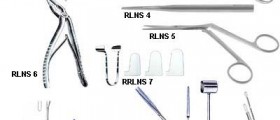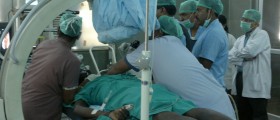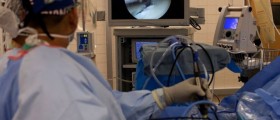
Endoscopic surgery is a specific type of surgery, not as invasive as open surgery, performed through small incisions or natural body openings. It can be a powerful tool for diagnosing and treatment of many different medical conditions. The term minimally invasive surgery, which is often used from this treatment approach, stems from the fact that it does not include cavity invasion. Instead the penetration and damage to the operated organ is minimal.
Endoscopic Sinus Surgery
The sinuses are air-filled cavities in the cheekbones and forehead. They are in contact with and drain through the nasal cavity. There are several functions sinuses perform. Firstly, they keep the head lighter by reducing the total weight of this body part. They also participate in mucus production. The mucus enters the nose, keeps the mucous membranes moist and assists in entrapment of dust and foreign particles as well as infectious agents we inhale while breathing. Mucus drains through the nasal cavity down the throat.
In case of sinusitis, the surface of sinuses gets inflamed. This leads to edema and congestion. Mucus remains in the sinuses instead of being eliminated and contributes to the onset of infection. The very inflammation and subsequent congestion are mostly associated with irritation caused by an allergy, exposure to some irritants (e.g. smoke) or is closely connected with infections of the upper respiratory tract.
Inflammation that lingers for more than 12 months is classified as chronic sinusitis. In such patients decongestion and pain relief simply cannot be achieved with nasal sprays or drops and regular pain killers. What is more, the congestion becomes severe, making patients practically breathe through their mouth. These individuals require surgery.
Endoscopic sinus surgery is indicated in patients suffering from chronic, persistent and recurrent forms of sinusitis. The entire procedure is performed with the assistance of a tiny little telescope which is, together with surgical instruments, inserted through the nasal cavity into the sinus. Prior to the procedure doctors determine whether the person is suitable candidate for the surgery. Only those who have been suffering from severe forms of chronic inflammation of the sinuses which cannot benefit from conservative approach any more should be operated. Apart from being indicated in case of chronic sinusitis, endoscopic sinus surgery is also a suitable treatment option for people in whom inflammation of sinuses develops as a result of nasal polyp blockage.
How is the Procedure Performed?
Practically all patients are explained how to prepare for the surgery and what to expects. They also get familiar with potential complications and side effects as well as the time required for them to fully recover.
This is a relatively simple procedure, performed as a day case. This means that patients do not remain hospitalized but instead go home several hours after the surgery. Only in rare instances, usually when there are complications, patients might stay overnight in a hospital.
Endoscopic sinus surgery can be performed under general or local anesthesia. If local anesthesia is applied, patients are additionally administered sedatives which make them relax. Prior to procedure all individuals are due to sign a consent form for the procedure to go ahead.
During the very procedure surgeons insert a narrow and flexible tube inside the nasal cavity and push it towards the affected sinus. The tube perfectly visualizes the inside of these cavities. It also helps doctors insert small instruments which are manipulated with during the surgery. The excess of sinus mucous membrane is removed. During the procedure doctors may also remove a nasal polyp, another potential underlying cause of chronic sinusitis. In the end the nostrils are filled with absorbent dressing which will reduce bleeding and absorb the postoperative discharge.
Soon after the surgery is done patients regain their consciousness but it might take some time for them to fully recover from anesthesia. This is why they have to have someone who will help them get back home and take care of them during the rest of the day. Once the effects of anesthesia wear off, the pain arises. Fortunately, it is easily dealt with painkillers which are prescribed right before discharge from the hospital.
It is important to follow all the rules regarding carrying the wound. The dressing in the nose will remain until the following day when it is removed. The first follow-up appointment is also the day after the surgery.
The recovery after endoscopic sinus surgery does not last long. First of all, patients are supposed to abstain from driving, drinking alcohol and operating heavy machinery within 24 hours after the surgery. Pain is alleviated with prescribed pain relieving medications such as paracetamol. It is normal to experience blockage immediately after the surgery because the very manipulation inside the sinuses lead to swelling. The swelling subsides after a couple of days. Mucous membrane of the sinuses and nasal cavity are very delicate after the surgery and may bleed easily. This is the reason why patients should not blow their nose within 2 days after the surgery. Most patients return to work after a week or two.
And finally, when it comes to potential complications these include bleeding, damage to the eye socket (orbital bleeding, abscess or damage to the optic nerve), leaking spinal fluid and nasal complications such as adhesions, anosmia (inability to perceive odors) and injury to the lacrimal glands.

















Your thoughts on this
Loading...